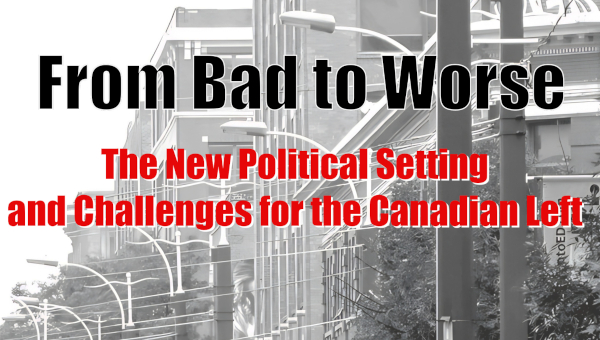Public Sector Workers: The Recession’s Next Victims?
I fear that Tom Walkom of the Toronto Star is bang on when he argues that the next victims of the recession will be public sector workers. As he writes:
“The federal government has already signalled plans to get tough with its workers. In Ontario, Premier Dalton McGuinty gave notice this week that the province’s public sector – including nurses, doctors, teachers, police officers and judges – will no longer be ‘sheltered’ from recession. New Brunswick plans to cut 700 civil service jobs, while Alberta’s provincial government is asking its teachers and health-care workers to accept wage rollbacks….
[T]he biggest target promises to be the unionized public sector. Approximately 70 per cent of Canada’s 3.3 million public sector workers are unionized.
Here, the hammer will again be the deficit. Governments, faced with declining tax revenue and on the hook for so-called stimulus spending, are already announcing plans to cut back. With few social programs left to slash, expect them to directly attack unionized public sector wage bills.
It will be mean and bloody-minded. Given the fact that almost everyone else in the country has already been whacked, it will also be darkly popular.”
While Walkom is probably correct that the right will not find it too hard to whip up sentiments against supposedly ‘cocooned’ public sector workers, we should be careful not to buy into the idea that, as he puts it, “almost everyone else in the country has already been whacked.”
Public Sector Workers Unscathed?
True, the private sector has borne the brunt of the recession, but much of the job loss impact was felt in manufacturing, resources and construction as opposed to private services. While private sector payroll employment fell by 449,000 or by 4.1% over the past year (October to October), over three quarters of the job losses were in the goods sector. While some private sector workers have obviously been hammered, the fact remains that well over 90% of private workers have probably not been directly impacted. Thanks to very low inflation caused by the crisis, average hourly pay has actually risen significantly for the great majority of workers who have kept their jobs. The stock market recovery already has the high rollers on Bay Street proclaiming the end of the recession – for them.
Meanwhile, it is something of a myth that the public sector has been completely unscathed. Between October and October, public sector employment fell by 54,500 or 1.6%.
And the growth of deficits has almost nothing to do with public sector workers. The major increases in spending have – appropriately – been on Employment Insurance (EI) benefits and on various stimulus packages directed to sustaining private sector jobs, especially in construction.
There are tons of misinformation being spread around by the likes of the Canadian Federation of Independent Business (CFIB) about the superior pay and benefits of public sector workers. Controlling for education and skills – which are, on average, higher among public sector workers – there is only a small pay gap. And it is attributable to more equal pay for women compared to men in public services. Women in lower paid, lower skilled occupations do better in the public than in the private sector, and that is a good thing.
At the high end of the pay spectrum, the public sector pays less, often far less. Over the past decade 1999 through 2008, public sector union members averaged pay settlements of 2.9 percent per year, slightly ahead of 2.6 percent in private sector, and only slightly ahead of inflation. However, private settlements were bigger every year in the decade 1989 to 1999, as well as in 2004 and 2005. Over the past two decades, public and private sector pay settlements have come out just about equal.
Pension coverage is much higher in the public sector. But those pensions are financed by worker and employer contributions comparable to those for large private sector plans, with shortfalls generally resulting in higher contributions or reduced benefits (ask Ontario Teachers.) It is a myth that taxpayers are on the hook to pay huge unfunded liabilities. To the contrary, some governments – including the federal government – have scooped up public sector pension plan surpluses.
None of which is to say that the right and some private sector employers will not target public sector pay and benefits, as Walkom argues. But, make no mistake, the true target is the wages and benefits of all workers.
Exit Strategies and Fiscal Restraint
This battle will, of course, be fought by right wing (and perhaps not so right wing) governments in the name of ‘fiscal responsibility,’ and justified with reference to the imperative need for ‘exit strategies’ from the Great Recession deficits and debt accumulation.
The International Monetary Fund staff recently (November 3, 2009) put out a report on fiscal sustainability which attracted some media attention and painted a rather grim outlook for the advanced industrial countries, calculating that the primary budget balance will have to be increased by a hefty eight percentage points of GDP from 2010 levels to bring government debt down to a tolerable 60% of GDP by 2030.
The Parliamentary Budget Officer has also reported and expressed concern that the federal government will be running a large structural deficit of $18.9-billion by 2013-14. And the TD Bank have issued a major report on “the coming era of fiscal restraint” which calculated that trend federal and provincial spending will have to be limited to just 2% if fiscal balance is to be restored by 2015-16 – which implies significant cuts in discretionary spending.
While some media reports have drawn on this material to suggest a 1990s style fiscal armageddon is once again on the horizon, on close reading all of these reports can be seen as quite moderate in tone. All note that the Canadian fiscal situation is far, far better than that of the other advanced industrial countries due to the surpluses we ran from the mid 1990s courtesy of the deep spending cuts of Martin, Harris and Klein. For example, the IMF calculate (Table 7) that the total government structural deficit in Canada in 2010 will be just 1% of GDP compared to a G20 advanced country average of 3.4%. The required fiscal adjustment for Canada 2010 to 2020 is an estimated 3.1% of GDP compared to the G20 advanced country average of 8.1%. Trimming spending or raising taxes by 3.1% of GDP is not trivial, but it falls well short of the 10.4% of GDP fiscal consolidation Canadians endured in the 1990s. The TD report similarly notes that gross and net debt to GDP ratios in Canada are currently very modest compared to other countries and compared to the early to mid 1990s.

The estimated deficit and debt trajectories embodied in these reports are reasonable enough on the surface, but one can question the need for a relatively quick return to budget balance as per the conventional wisdom. Unlike previous recessions, interest rates are likely to remain quite low for some time, especially if there is no significant resumption of growth. This will forestall the pernicious high interest rate/high deficit interaction which got us into such trouble in the early 1990s.
Given low interest rates, we can and should go ahead with public expenditures which are significant investments in our productive potential and thus raise the future tax base. To my mind that includes all levels of education, from early learning to post secondary education, training, and a lot of public infrastructure and green investments.
Further, the fact that the structural deficit is estimated to be modest means it could be easily addressed by modest tax increases rather than by major spending cuts. Simply reversing the two point cut to the GST (which costs about $12-billion per year) all but eliminates any federal structural deficit. Provinces also reduced revenue to GDP ratios in the recent past (something which is much less noted than a modest uptick in program spending.)
Expanding the Fiscal Base and Income Taxes
I entirely take on board Hugh Mackenzie’s important argument that we need an adult discussion about taxes which recognizes that decent levels of public services and social programs have to be paid for from a broad tax base, including consumption taxes. If we want Scandinavian type welfare states, we will have to pay Scandinavian level taxes. That said, as I have argued elsewhere, we could and should gain useful amounts of revenue, to the tune of several billions of dollars, by levying higher rates of income tax on the very, very affluent.
True, the very rich are few in number, but they do have a high and rising share of all personal income. Corporations could also pay more – though I incline to the argument that we should redirect higher corporate tax revenues into more effective ways of supporting private investment rather than into general revenues. In short, there is no fiscal crisis. To the extent that we have a fiscal problem, it can be squarely addressed on the tax front.
But one caveat. The fiscal outlook for a few provinces, notably Ontario, is grim. Ontario is today running a deficit of almost $20-billion, equal to two thirds of the combined all Canada provincial deficit, and almost as high as the federal deficit as a share of GDP (3.2 vs 3.7%). Ontario’s revenue base has been particularly hard hit by the crisis, and it won’t bounce back quickly given the massive shrinkage of industrial capacity. Arguably, enhanced fiscal support from Ottawa will have to be part of any Ontario fiscal solution. •




